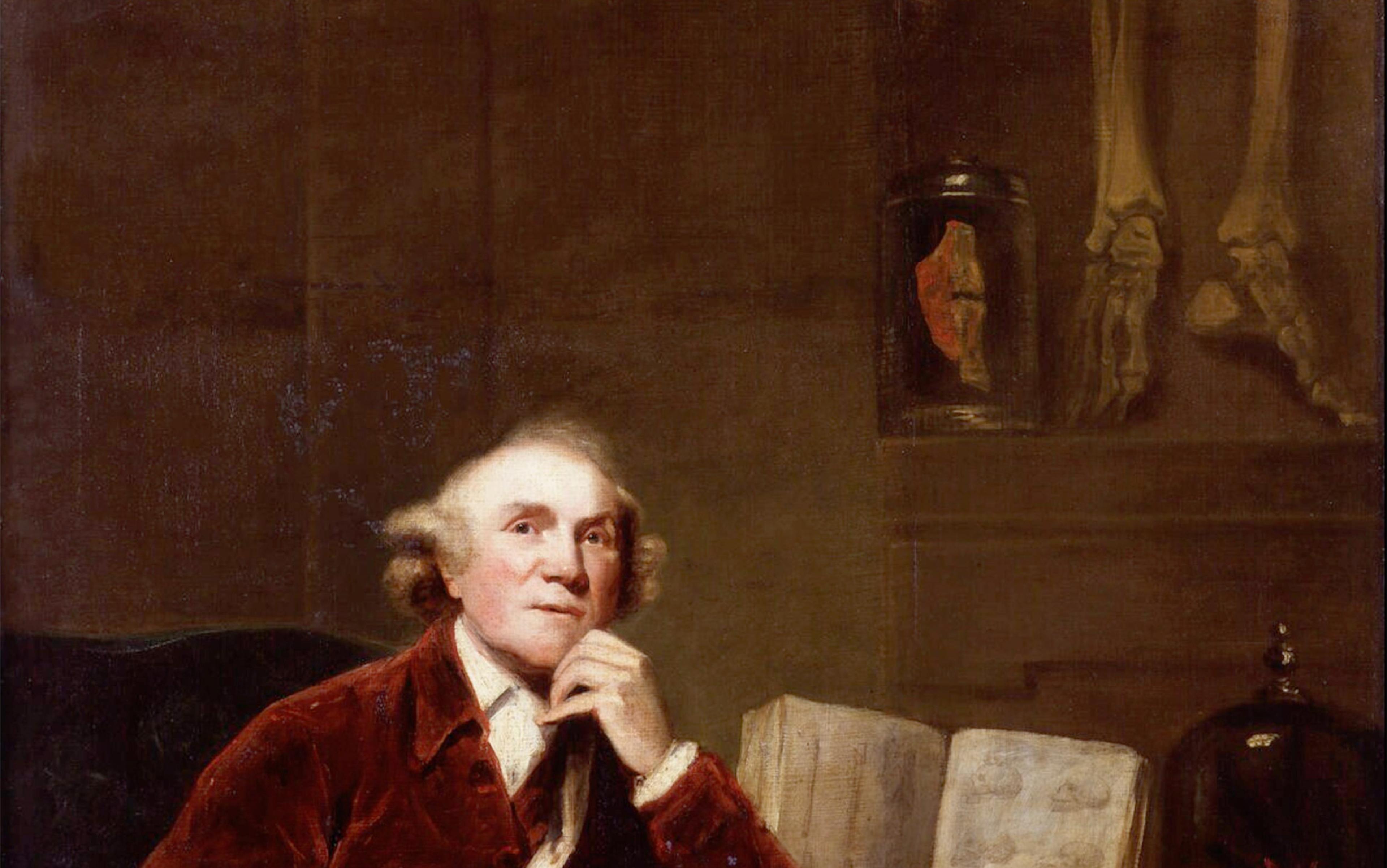In 1786, Joshua Reynolds painted a portrait of the surgeon and anatomist John Hunter. Reynolds depicted Hunter gazing into the distance, caught in mid-thought, quill in hand. On the table in front of him, apart from inkwell and paper, are some books, one propped open to a page comparing the skulls and arm bones of humans and apes. Next to the books is an anatomical specimen under a glass dome. In the upper right-hand corner is a mantel holding another anatomical specimen in a glass jar. A pair of large skeletal feet suspended in the air next to the jar hint at the large skeleton attached to them and hanging from the ceiling.
The painting was well known, particularly after an engraving of it was made in 1788, and the dangling feet were also famous. Their inclusion in the portrait indicated that Hunter owned them and the skeleton to which he had re-attached them. However, in life, they had belonged to the ‘Irish Giant’ Charles Byrne.
I first saw Byrne’s skeleton decades ago in the Hunterian Museum of the Royal College of Surgeons in London, among jars of preserved anatomical specimens that included an 18th-century bishop’s cancerous rectum. The last time I saw the skeleton, in 2016, I was not allowed to photograph it. The following year, the outcome of the case of an ancient skeleton in the United States brought to a head long-simmering issues surrounding the rights of the dead against the rights of museums to display their remains and of scientists to learn from them.
The contrasts are many between Byrne and the man who died 8,500 years ago and was buried along what is now known as the Columbia River near Kennewick in Washington state. Nonetheless, there are similarities between them. They share stories of identity and ownership in the aftermath of colonialism. More broadly, both men seem to epitomise science’s appropriation of individual identities in the service of a larger impersonal goal of knowledge that presumably will benefit humankind. By this argument, a dead body has no value other than as a source of information. Yet the stories of these two men, vastly separated in place and time, are not merely stories of a cold and rapacious science, but of the intertwined desires and beliefs that the living project onto the dead, both in the 18th century and today, both among scientists and among others who lay claim to the bodies of the dead. The dead themselves know nothing about it.
For several years, Charles Byrne, born in 1761 in County Derry, exhibited himself for a fee to the public at fairs, in taverns and coffeehouses, and at private homes across Ireland and Britain. Newspaper advertisements and broadsides breathlessly proclaimed him to be the tallest man in the world, at a height of 8 ft 2 in. We know little about him apart from his height, which was actually about 7 ft 7 in (2.31 m). His parents were of normal size but, since he hired himself out for money while still in his teens, they were most likely poor. His handlers dressed him in the height of 1780s fashion, with silk stockings and lace cuffs, and broadsides posted on walls across London announced his arrival in April 1782. The broadside described ‘The Modern Living Colossus, Or, Wonderful IRISH-GIANT’ noting his ‘admirable Symetry [sic] and Proportion’ and his ‘Vivacity and Spirit’.
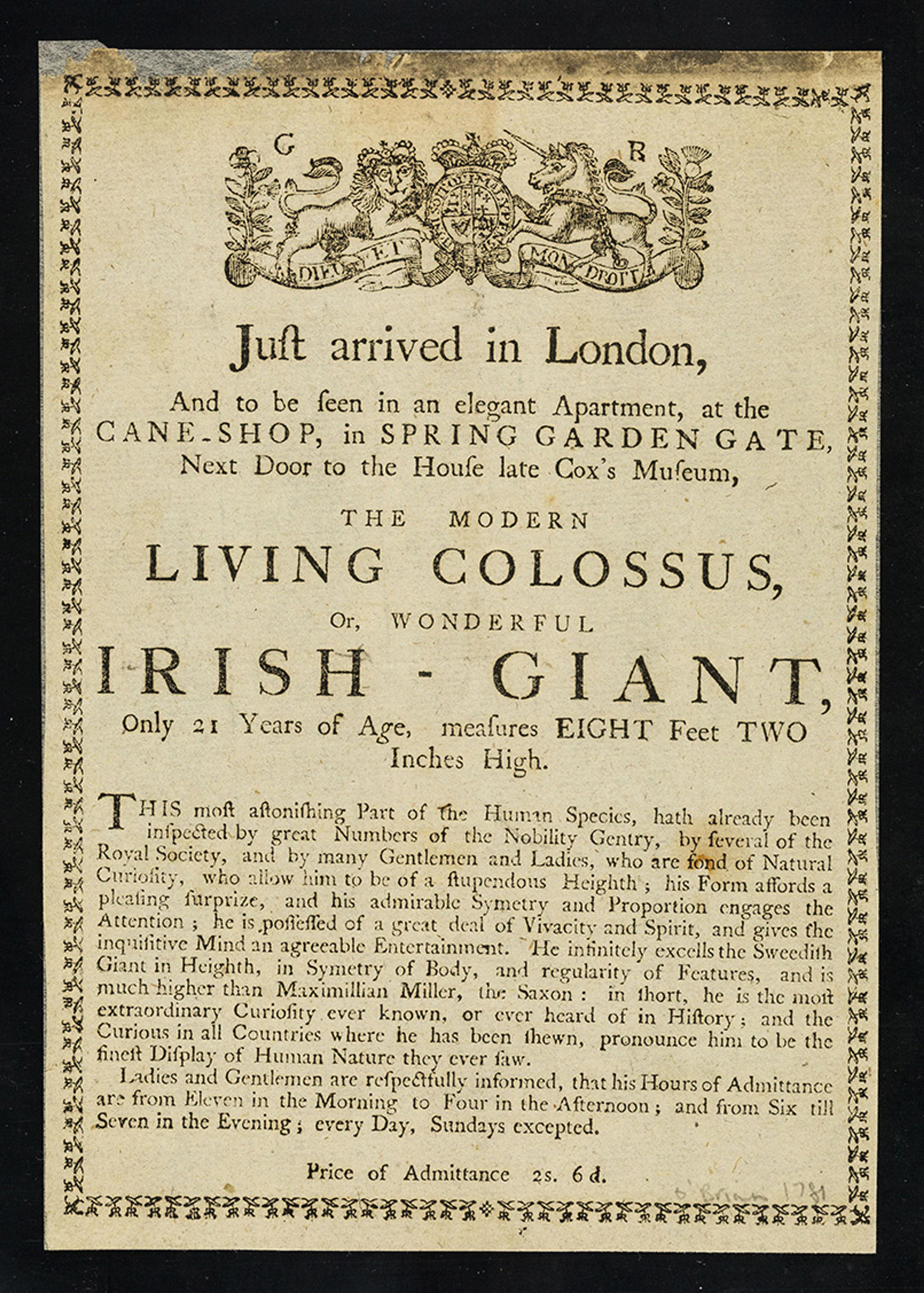
Byrne’s Irishness was part of his appeal. He was sometimes referred to, or referred to himself, as O’Brien, invoking an ancestry going back to the semi-mythical 11th-century Irish king Brian Boru, who in some tales was a giant. In Hilary Mantel’s novel The Giant, O’Brien (1998), Byrne is a storyteller, a myth-spinner, in contrast to Hunter’s cold rationality. Byrne was not the first Irish giant to display himself, and he would not be the last. Patrick Cotter, who really was eight feet tall, assumed Byrne’s role after his death. He also called himself O’Brien, and the two merged in the popular imagination.

Hunter would eviscerate it, dismember it, boil it until the flesh came off, and assemble the bones into a skeleton
By the spring of 1783, only a year after his triumphant entry into London, Byrne was in constant pain, his bones cracking under his weight. Newly destitute, robbed of his life savings, he was busily drinking himself to death. He was 22 years old, and he knew that Hunter wanted his body after he died. The anatomist had offered to pay Byrne a sum of money if he would bequeath him his body. This was not an uncommon practice. Forty years earlier, the ‘Irish Dwarf’ Owen Farrell had made just such an arrangement with a surgeon. The value of Farrell’s bones, at least initially, was as a curiosity: they entered the collections of the Duke of Richmond. Hunter’s brother William, who purchased the skeleton at an auction after Richmond’s death, was more interested in Farrell’s abnormally bony cartilage.
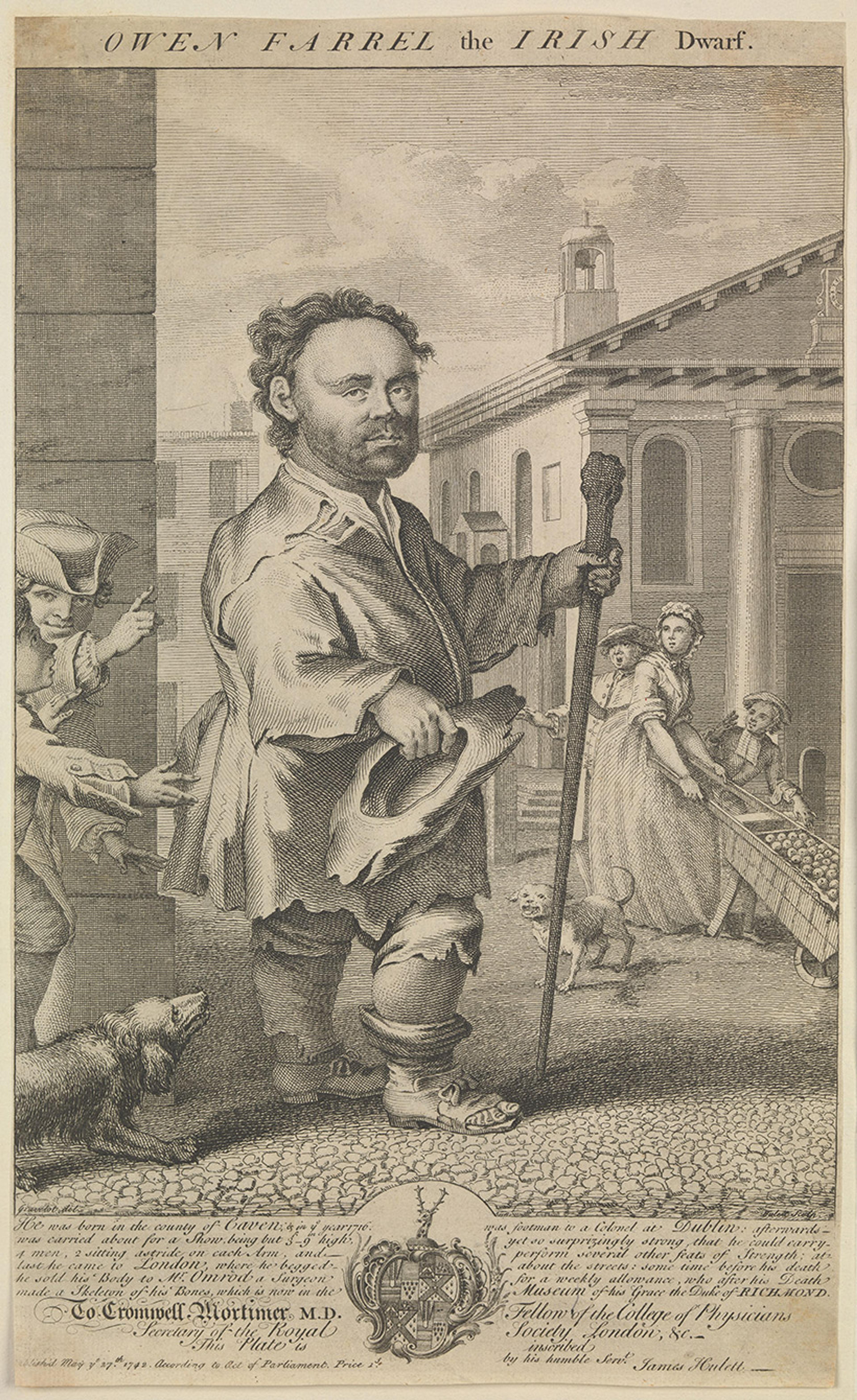
Byrne knew that if he granted John Hunter’s request, his body would share the fate of Farrell’s: Hunter would eviscerate it, dismember it, boil it until the flesh came off, and assemble the bones with wires and rods into a skeleton. Byrne refused Hunter’s offer, and took steps to ward off this fate, arranging with friends to seal his dead body in a lead coffin and pay for its transport to the coast for a burial at sea, far from Hunter’s predatory hands. Or perhaps the burial was to be in Ireland. There are many accounts and they say different things. The announcement of Byrne’s death in Parker’s General Advertiser in June 1783 noted that ‘His remains are secured in his coffin, which measures upwards of eight feet four inches.’ Although his friends were ‘determined to have him carried to Ireland in a few days’, they first offered to show the coffin to the public, for a fee of two shillings and sixpence apiece.
The coffin never made it, either to Ireland or to the coast. Accounts also differ of how Hunter obtained Byrne’s body; the London Morning Chronicle declared that Hunter paid 125 guineas, more than £20,000 today, for the body. Others claimed he paid £500. Possibly the friends who exhibited the coffin sold the body to Hunter. In any case, Byrne’s next public appearance was his skeletonised feet in Reynolds’s portrait. Hunter declared that his interest in Byrne was purely scientific. Examining the extremes of nature, as well as normal specimens, gave him insights into its inner workings. He amassed an enormous collection of human and animal skeletons, skulls and anatomical preparations housed both at his home in Leicester Square and his country house at Earl’s Court, where he also maintained a menagerie. While his collections were primarily for his own research, from 1788 onward he opened his home at Leicester Square for public viewing a few times a month. He put the skeleton of Byrne on display as part of a case depicting the growth of bones.
Hunter died in 1793, and in 1799 his anatomical collections, including Byrne’s skeleton, were purchased by the British government and transferred to the Company of Surgeons, which later became the Royal College of Surgeons of England. The College’s museum opened in 1813, and Byrne’s skeleton remained on display there for the next two centuries. In 1909, a US surgeon sawed open Byrne’s skull and found evidence of the pituitary tumour that caused the release of excessive amounts of growth hormone. Later, DNA was extracted from one of Byrne’s teeth. At some point in the 19th century, another skeleton joined Byrne’s on display. Known as the ‘Sicilian Fairy’, Caroline Crachami died in 1824 at the reputed aged of nine. At the time of her death, she was around 20 in (50 cm) tall – the size of a newborn infant – making her one of the smallest humans ever recorded. The two skeletons survived the Blitz in 1941, which destroyed much of Hunter’s collection, but were put in storage in 2017 when the museum closed for renovations.
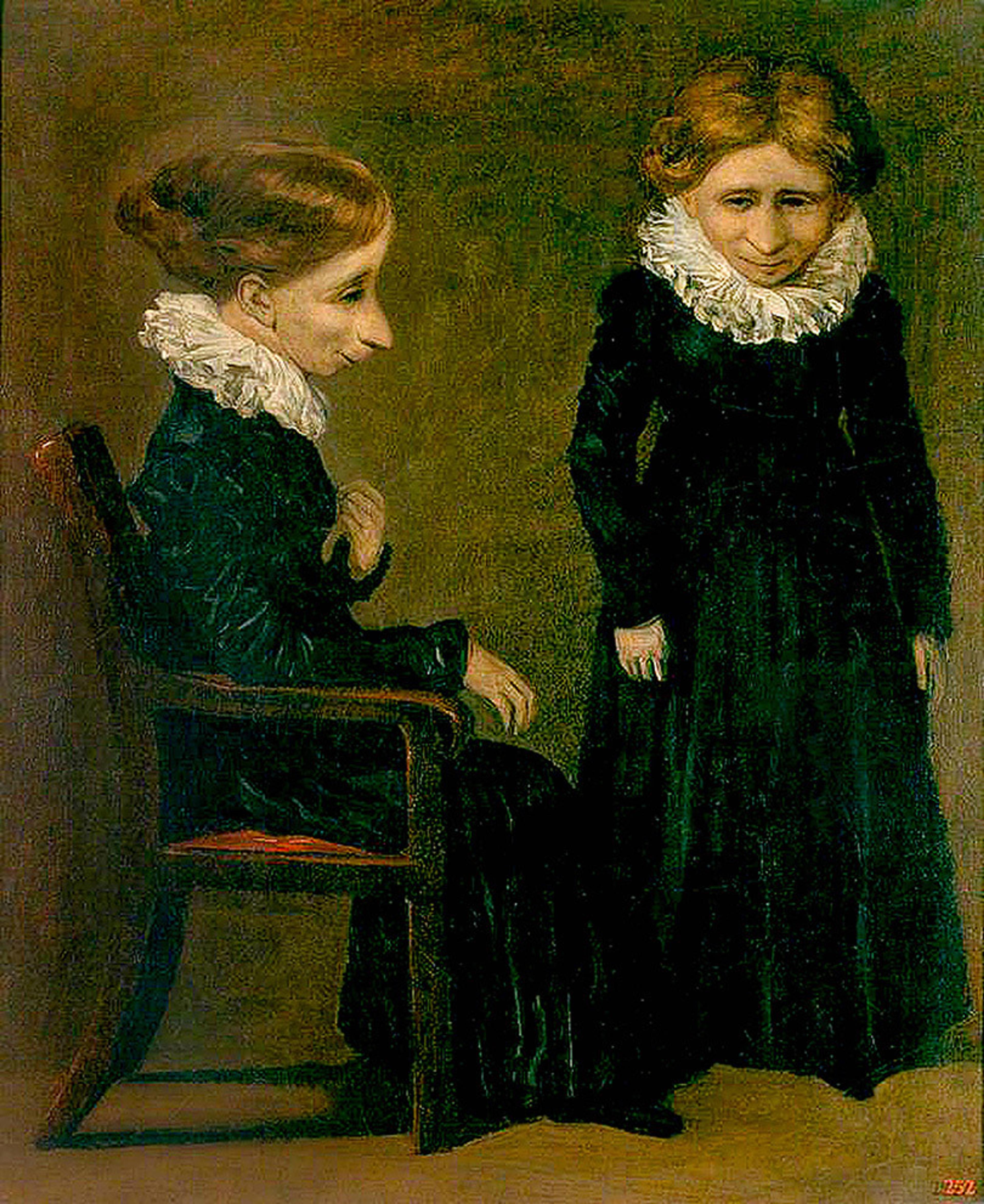
A second story of identity and ownership of a dead body began in the summer of 1996, when some teenagers found a skull along a bank of the Columbia River. The man who had been buried there some 8,500 years ago was tall for his time, at around 5 ft 7 in (1.7 m), but he was not a giant. His burial was deliberate, with his body laid on its back, parallel to the river and with his head pointed upstream. When his skull eventually emerged from the riverbank, time had already removed his skin and hair, his eyes and tongue. The teenagers who found it assumed it belonged to the victim of a murder and called the police. The nearest town, Kennewick, is near the confluence of the Columbia with the Yakima River to the west and the Snake River to the east, and the waters here are bisected by the McNary Dam. The skull came to the local coroner, who called James Chatters, a local archaeologist, to determine if it belonged to a crime victim. Chatters recognised that the skull was quite old and, judging by its shape, he at first believed it had belonged to a white settler. Returning to the site, he found some 300 bones and fragments: nearly a complete skeleton. Carbon-14 testing on a finger bone initially established its age at around 9,000 years old.
The emergence from the muddy shore of these bones – who came to be called either ‘Kennewick Man’ or ‘the Ancient One’, depending on the speaker – opened a 20-year debate about ownership, heritage and science. Although this story was in some ways uniquely American, it also spurred global disputes that are still ongoing. The McNary Dam site is owned by the US government and managed by the US Army Corps of Engineers. The Corps issued the permits that allowed Chatters to find more of the skeleton and, once the age of the bones became clear, the Corps took possession of them. Since they dated from long before 1492, the course of action for the Corps seemed clear. Under the provisions of the six-year-old Native American Graves Protection and Repatriation Act (NAGPRA), if the bones were pre-Columbian, they were by definition Native American. If the bones were Native American, the Corps was obligated to repatriate them to local tribes. Five local Native American tribes had already claimed Kennewick Man as an ancestor, ‘the Ancient One’.
At this point, only a few months after the discovery of the bones, Kennewick Man was already renowned in the archaeological world. At that time, few bones of such an advanced age, and only one other skeleton, had been found in North America. Theories of the populating of North America, including when it occurred, where it originated and by which route, were in flux after years of consensus. New methods of analysis including CAT scans and 3-D modelling helped to reconstruct what skeletal bodies looked like when alive, while stable isotope analysis – which considers the ratios of stable isotopes of carbon and nitrogen in bones – reconstructed the diets, and the origins, of the long-dead. These and other methods were changing the picture of late Ice Age America. Most exciting was the potential of DNA analysis, which was in its infancy in the 1990s. Chatters had just sent a finger bone out for DNA analysis when the Corps ordered him to stop any further testing.
The bones of Kennewick Man had been in a box, in plastic bags and in an evidence locker
A group of anthropologists and archaeologists sued the Corps to prevent repatriation, arguing that the identity of the bones had not yet been determined, and that therefore NAGPRA did not apply to them. They pointed to the need for further study, which the five tribes strenuously opposed, calling for the bones to be buried without further analysis. Ironically – and this case is drenched in irony – because the Federal court agreed that the identity of the bones could be determined only scientifically, the scientists were freed to conduct studies to determine that identity. These studies mostly focused on craniometry, the size and shape of the skull, which many believed to indicate a non-Native American identity. Chatters published images of the skull in 1996 and 1997, and identified its shape as ‘Caucasoid’, an archaic racial classification that some construed as racist. The facial reconstruction Chatters made from a resin cast of the skull, published in Science magazine in 1998, most resembled the actor Patrick Stewart (Chatters admitted that he was a fan of Star Trek). White supremacist groups in the US seized on the ‘Caucasoid’ label to argue that white Europeans had settled the Americas before any ancestor of modern Native Americans.
By then, the bones had been deposited in the Burke Museum at the University of Washington, where they remained securely stored and were never displayed. The 2004 judgment in the lawsuit against the Corps declared in favour of the scientists. The settlement opened the door to a more detailed study of the remains over the next decade, resulting in what seemed to be the definitive account of the bones. Ten years later saw the publication of Kennewick Man: The Scientific Investigation of an Ancient American Skeleton (2014), edited by the anthropologists Douglas Owsley and Richard Jantz.
The study described Kennewick Man as relatively tall, ‘broad-bodied, and massive’. But was he an ancestor of modern Native Americans? Amid an avalanche of data on diet, overall health and burial conditions, the critical question of identity remained focused largely on the skull. Some anthropologists thought it resembled the modern Ainu of Japan, an Indigenous people who predate the Japanese but whose ancient origins remain debated. Additional analysis suggested that the skull showed most affinity with Polynesians, indicating a common set of ancestors. This theory in turn fit new ideas of multiple migrations from Asia to the Americas, with some travelling across the sea and perhaps predating those who came overland from Siberia across the Bering Land Bridge. Owsley and Jantz concluded that ‘Kennewick Man … differ[s] from modern American Indians in systematic ways … their difference is mainly genetic and as such carries information about their history and biological affinities,’ although the proofs they presented were mainly morphological. Throughout the volume, Kennewick Man is referred to as a ‘Paleoamerican’ rather than the more common name of ‘Paleoindian’, in an attempt to demarcate differing ancient groups. A new reconstruction of his face resembled photographs of Ainu men, with a full beard and lightly tanned skin.
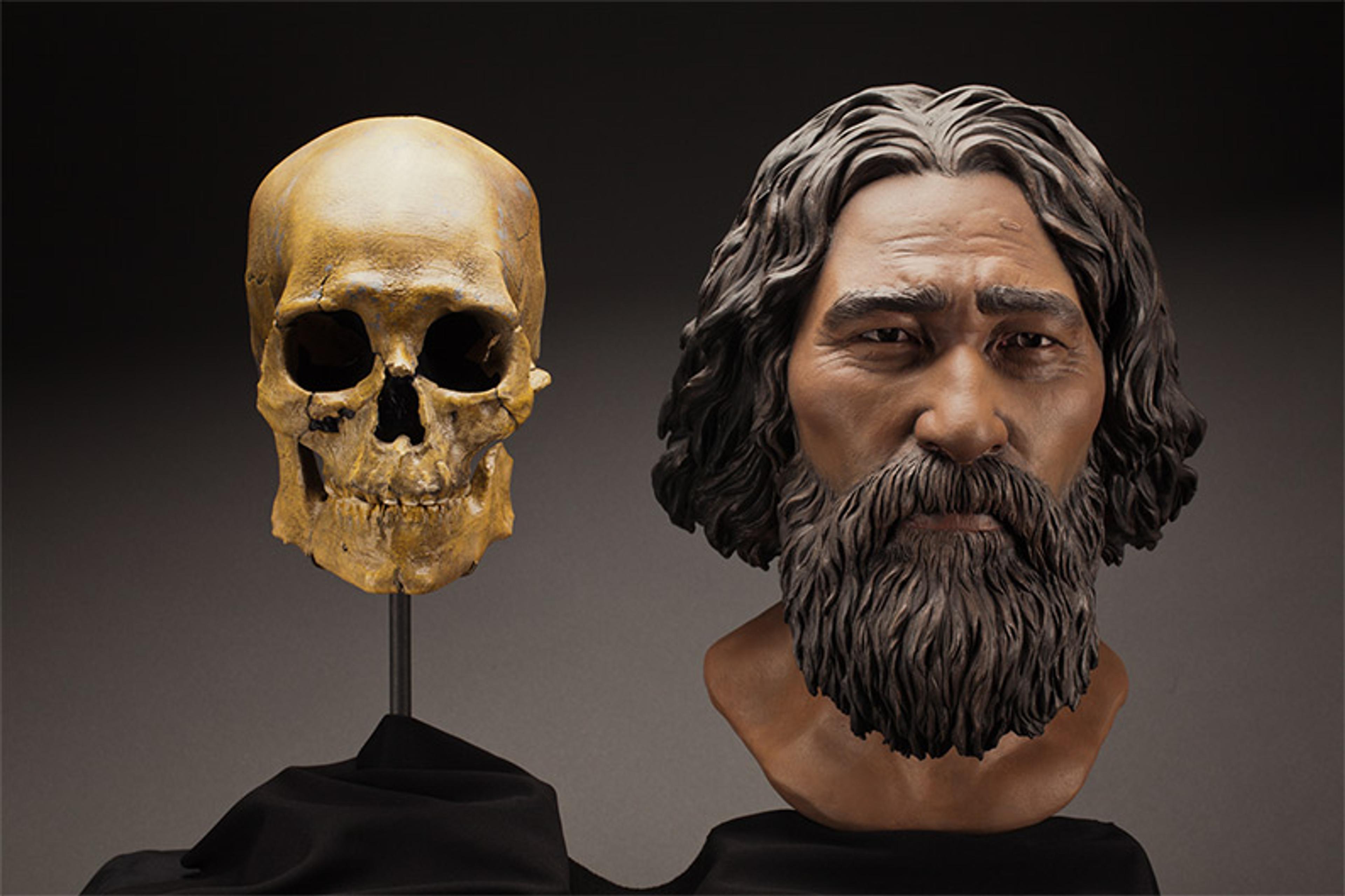
A little more than a year after the publication of Owsley and Jantz’s volume, the carefully constructed chain of identification fell apart when the results of DNA analysis showed that ‘Kennewick Man is closer to modern Native Americans than to any other population worldwide.’ An article in Nature magazine in July 2015, authored by a team led by the Danish scientist Eske Willerslev, reported the results of the analysis. The team had sequenced the genome of Kennewick Man and compared it with other populations, particularly other Native American populations. The closest relationship appeared with the Confederated Tribes of the Colville Reservation, one of the five tribes who had claimed Kennewick Man as the Ancient One nearly 20 years earlier. The Colville tribe was the only one of the five that agreed to provide DNA samples for comparison.
The development of research on what is known as ancient DNA or aDNA had progressed rapidly in the decade before the Nature article. Ancient DNA consists of short and degraded fragments that persist in materials such as bones and teeth, as well as hair, mummified skin and dental calculus. Although the first sequencing of aDNA occurred in 1984 from a museum animal specimen, the technological challenges to obtaining meaningful results from fragmentary and often contaminated evidence took years to overcome. Moreover, the interpretation of aDNA evidence required collaboration between bench scientists and social scientists, who had to overcome their mutual suspicion and develop a common vocabulary as well as a chain of ownership between excavation site or museum and laboratory that minimised contamination. For example, the bones of Kennewick Man had at various times been in a box, in plastic bags and in an evidence locker before their arrival at the Burke Museum, increasing their chances of contamination with modern DNA at each stop.
Perhaps most important, the analysis of aDNA is necessarily destructive. The sample to be analysed is reduced to a powder and treated with chemicals that purify the DNA from contaminants, isolate it, and extract and recover fragments. While improved technology has reduced the size of the sample required, the cultural significance of removing even a small sample from an ancient specimen cannot be ignored.
The results of the aDNA analysis fulfilled NAGPRA’s requirement of a preponderance of evidence, allowing the Corps to declare definitively that Kennewick Man belonged to the five tribes who had originally claimed him, and particularly to the Colville. The Corps confirmed what the five tribes had said all along: that the Ancient One was their ancestor. In February 2017, the Burke Museum turned over the bones to the tribes. As required by law, that meant all the bits and pieces, including what remained of the finger bone used for DNA testing, thus precluding any further testing. The Ancient One was reburied in an undisclosed location on the Colville Reservation along the Columbia River.
Such a resting place was not to be allowed to the skeleton of Charles Byrne. Calls for the burial of his bones – either in Ireland or at sea – began years before the Hunterian Museum closed for renovations in 2017. These calls intensified during the museum’s closure, with Hilary Mantel taking a prominent role. Every inch of Byrne’s skeleton had been measured and examined. A tooth had been extracted for DNA testing in 2011. Surely, Mantel and other advocates argued, science had learned all there was to learn. ‘He’s waited long enough,’ she said in 2020.
DNA testing had revealed that the pituitary tumour that caused Byrne to be a giant had a hereditary component. It was not merely a spontaneous mutation, but had a genetic basis, and the frequency of Irish giants was not merely apparent or coincidental but quite real. The giant Knipe twins, with whom Byrne had been depicted, had grown up in a neighbouring village to Byrne’s, and by this evidence they were most likely distant cousins. The genetic evidence showed that the giants trail went back for generations. Ireland really was a birthplace of giants.
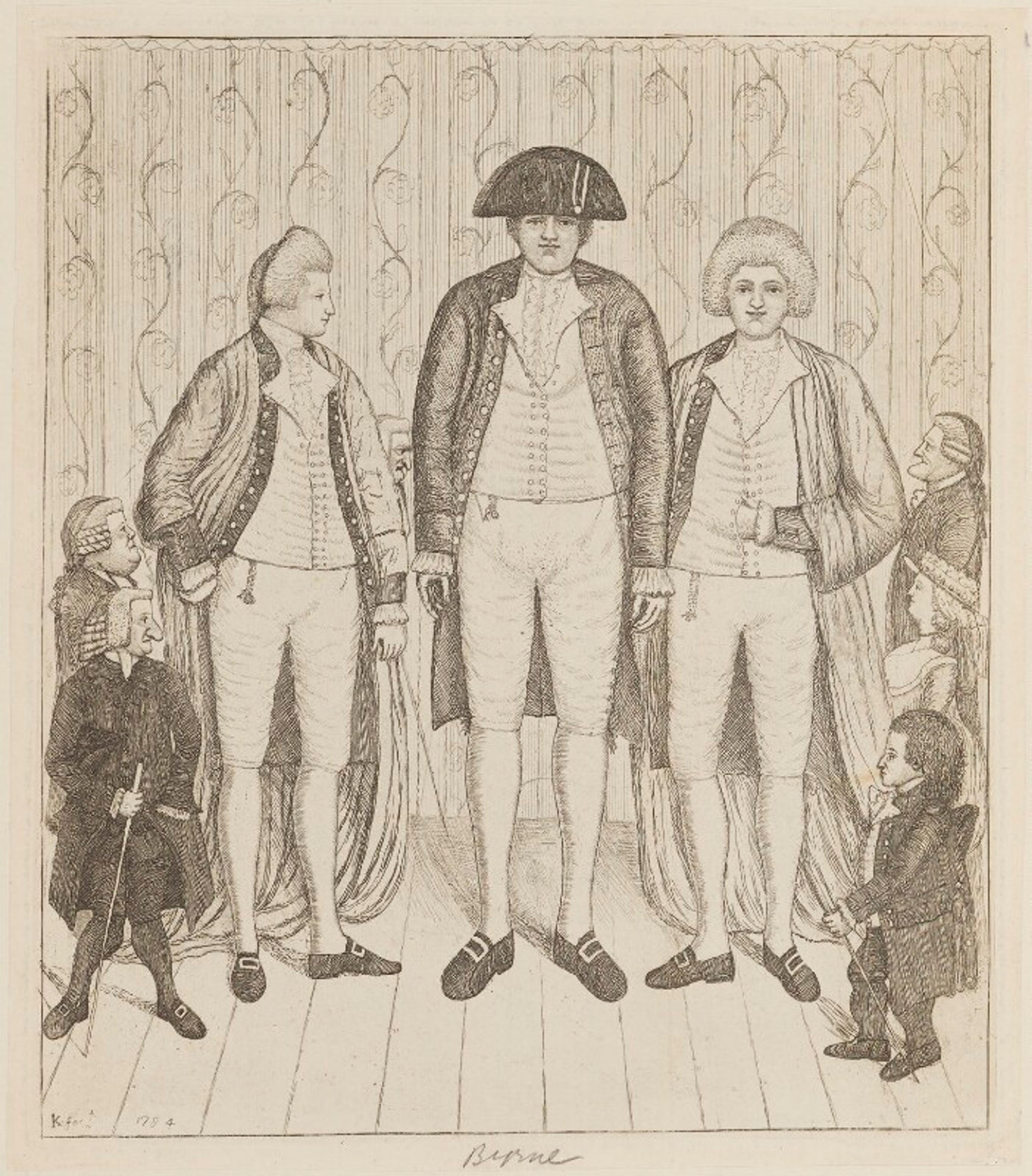
However, this evidence, far from persuading the museum that science had learned all there was to learn, led them to conclude that the bones still had more to tell. The scientists who had examined Kennewick Man would certainly agree with this assessment. DNA analysis and particularly the analysis of ancient DNA has been refined further and further in the past decade. Unlike Kennewick Man, Byrne has not been buried, although his skeleton was no longer on display when the Hunterian Museum reopened in May 2023. He remains in the museum as Osteo.223, available for future research. The tiny skeleton of Caroline Crachami, Osteo.227, also remains in storage at the museum.
The unwavering values of Native American communities claimed the Ancient One as their own
These stories affirm that the way the living have treated dead bodies throughout history is never about the dead but about themselves. The living give the bodies of the dead – and thus their own bodies – meaning, whether as relics, museum displays, scientific subjects or ones buried in the ground. Their status as colonial subjects made the remains of Byrne and the Ancient One particularly vulnerable to exploitation. In Byrne’s time, certain fields in Ireland were still littered with bones and skulls, the result of Oliver Cromwell’s brutal reconquest of Ireland in the 1650s. Byrne and his contemporaries assumed they owned their own bodies, believing therefore that they could control their disposition after death. But in Byrne’s case, he rejected the coldly transactional arrangements made by his countryman Owen Farrell, hoping to escape the fate of Farrell’s bones.
Although Mantel portrayed Byrne as a deeply spiritual man steeped in Irish mythology, in fact we know little of his spiritual or emotional life, or of his wider community. In contrast, the transformation of Kennewick Man into the Ancient One owed to the unwavering values of Native American communities who claimed the Ancient One as their own. However, the US government accepted these values only when science affirmed the claims. Moreover, although the Ancient One sleeps beneath the banks of the Columbia once more, forever lost to science, Native American bones and artefacts remain in anthropology departments and museum collections around the world.
The values of the community who have demanded the burial of Byrne are more diffuse, and the laws that govern the display of human remains in Britain are loosely interpreted unless the remains are under 100 years old, in which case they are subject to stricter regulation. Byrne’s bones hang in a storage room, awaiting further tests as the science of aDNA advances. Perhaps scientists will learn more about pituitary tumours from Byrne, and his body, racked with pain in life, will be able to prevent a similar fate for others. In place of the skeleton itself, visitors to the museum can view Reynolds’s depiction of his feet, hanging over Hunter’s mantel.
